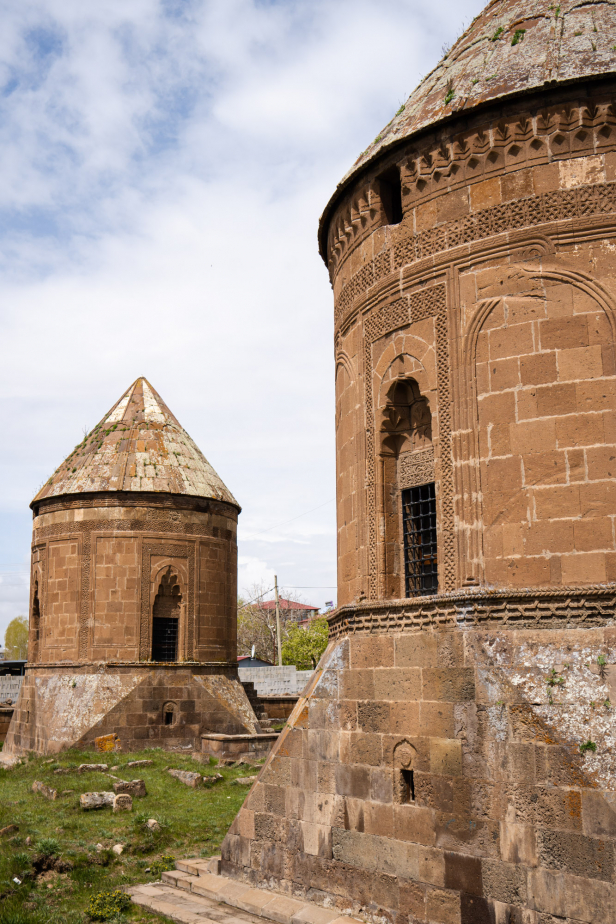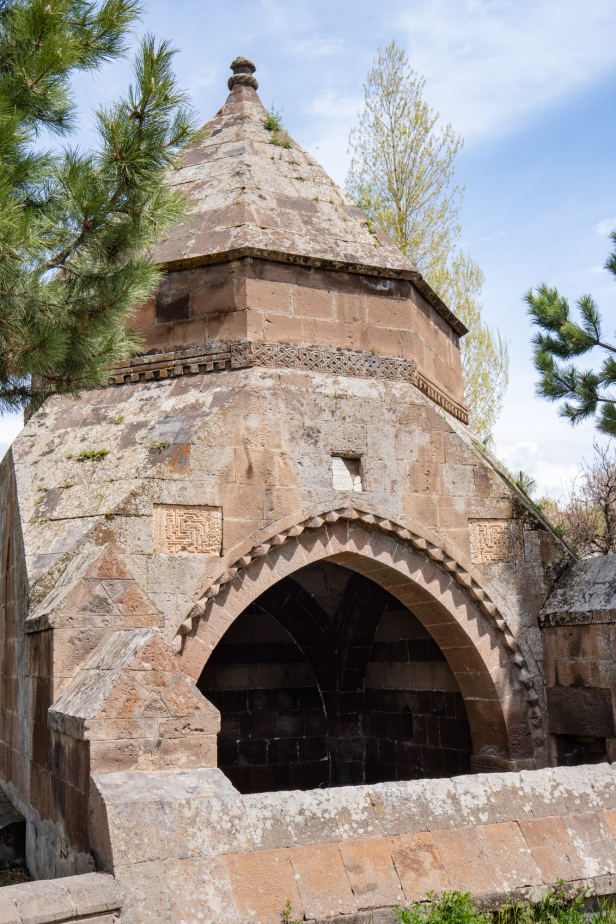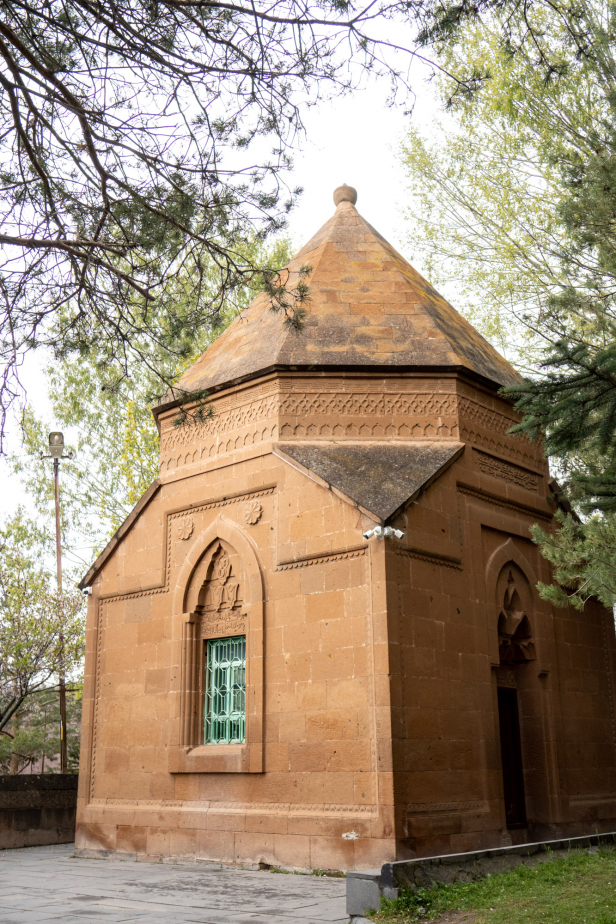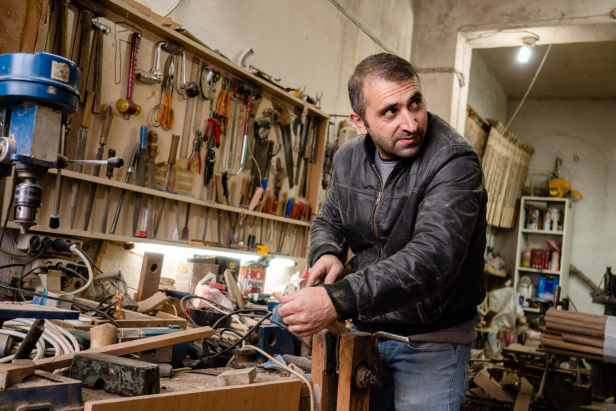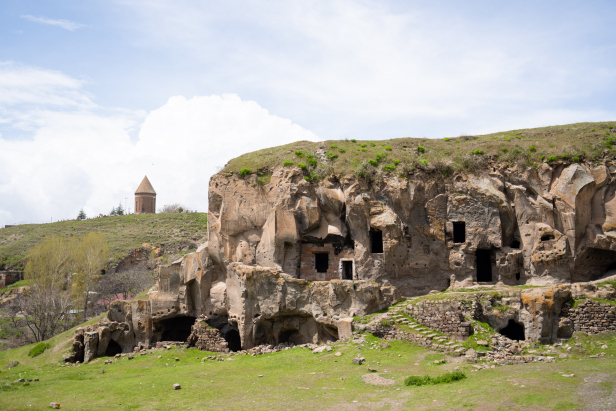The Seljuk Graves and Tombs of Ahlat
/ By Josh
The cultural landscape of Eastern Turkey is an incredible mix. Both in regard to history and its present, Turkey is full of Kurdish, Arab, Syriac, Armenian, as well as Turkic sites. The city of Ahlat is one of the few places in the east that has retained an overwhelmingly Turkic Identity for close to 1,000 years since the earliest stages of the Turkish conquest of Anatolia.
While Ahlat is a truly ancient city with roots stretching back to approximately 4,000 years, little remains from its storied past. The great exception are the thousands of monumental graves and tombs built by the Seljuks and the successive Islamic rulers of the city for generations. While Turkey is full of grand tombs and graves, Ahlat stands alone with its unique blend of scale and artistry displayed on hundreds of ornate gravestones and tombs.
History
First established as a Hurrian settlement around 4,000 years ago, Ahlat grew as an Urartian city in the early Iron Age. Ahlat was later a city of the Armenians, Persians, and Romans with dominion changing hands regularly. The city fell to the Arabs by the 7th century before it was retaken by the Byzantines with the Armenians occasionally gaining independent control. By the 11th century the city and much of the region fell under Seljuk control. The following centuries were marked by a changing of hands, often with local rulers serving as vassals to far away lords and emperors. The Ilkhanate Mongols, Aq Qoyunlu Turkomens, Timurids, and various Kurdish tribes had their time as rulers of Ahlat. In the early 16th century the city came under loose Ottoman control, with chiefs and rulers controlling their own territory with a great deal of independence until the 19th century.
Subscribe to The Art of Wayfaring
While the city was populated by a mix of Christian subjects and various Islamic rulers, the Muslim population seems to have often adopted the local funerary culture, with Mongols, Seljuks, and Ottomans adding to the forest of grand headstones and monumental tombs without straying too far from the older forms.
Why Visit?
Seljuk Graves of Ahlat
Selçuklu Mezarları
Cost: Free
The city of Ahlat is home to a number of Seljuk styled graveyards though none come close to the stunning scale and beauty of the Seljuk Graveyard (also known as the Meydanlık Graveyard). Carved of rust-coloured Ahlat Basalt, the graveyard is a sea of headstones rising out of the grass.
The graves of Ahlat tend to be built in a few related styles. While the majority of these styles include a headstone what is on the ground is subject to change. Some are designed as fully closed sarcophagi, others are like open boxes filled with soil. There are also a number of buried chamber tombs with only a headstone above or a small door set in the slope of a hill.
The headstones range in size though the largest reach a height of three meters. The surface of the stones are adorned with calligraphy, epitaphs, and carved motifs. Over the centuries the motifs used changed as cultural trends in art shifted. The earlier graves tended to have more of the sharp geometrical patterns of the Seljuks while the later graves used patterns with curves or stylistic flower motifs.
The Seljuk Graveyard was in use from the 12th to the 16th century and was used by the Seljuk Turks as well as other Islamic peoples who lived in the city. After the 16th century the primary grave site moved down towards the lake near the Ottoman Castle following the shift of the primary settlement.
Monumental Seljuk Tombs of Ahlat
Ahlat Kümbetleri
Cost: Free
Along with the magnificent graves of Ahlat are a number of exquisite monumental tombs, known as Kümbet. While there is no one perfect description of a kümbet, most tend to roughly follow the same design. Designs usually have an approximately cylindrical (or octagonal, dodecagonal) body topped by a conical or pyramidal roof. Often the cylindrical drum is set on a square base with a burial chamber below and a small prayer room above. In architecture, kümbet can also be translated as ‘cupola’.
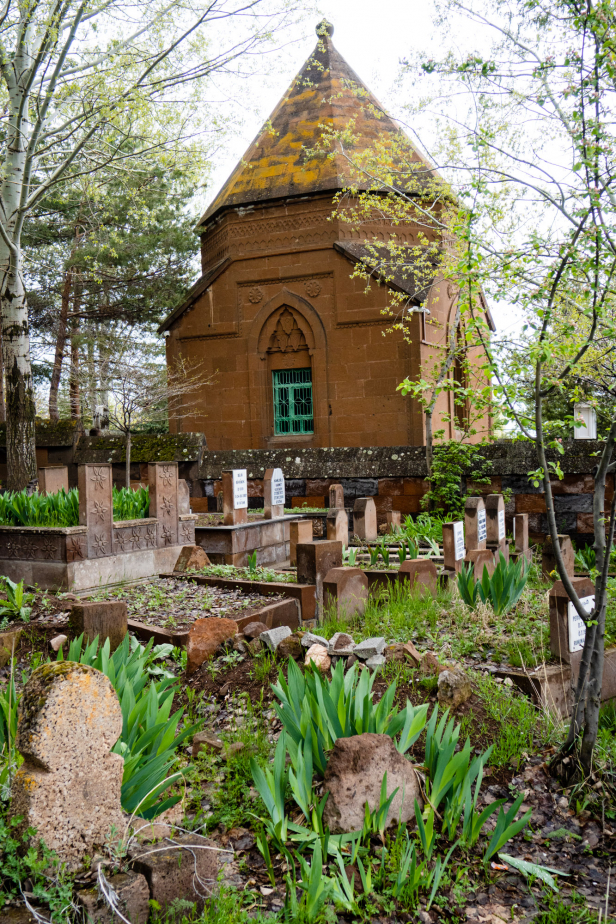
The exteriors of the Seljuk kümbet are often decorated with calligraphy, a moulding of muqarnas, and beautifully complex geometric patterns. In western Turkey the term “kümbet” tends to be replaced by the word “Türbe” a monumental tomb of the Ottomans.
List of Kümbet Tombs:
Ulu Kümbet / Usta Sakirt Tomb
At nine meters wide and 20 meters tall, the Ulu Kümbet is the largest in Ahlat. In design and ornamentation this 13th century tomb is the quintessential Seljuk kümbet. The cylindrical drum is capped with a conical roof with a prayer room inside. The circular footprint of the upper section transfers elegantly to the square burial chamber below with a set of triangular planes in the corners. The prayer room is reached via a double set of stairs.
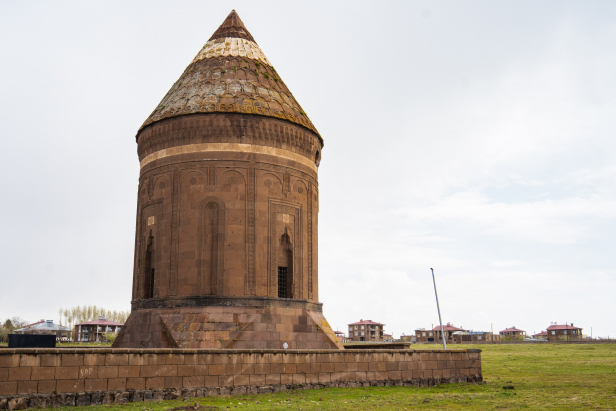
The name Ulu, meaning “Great” is in reference to its size, while its other name comes from its semi-legendary history. Lacking in inscriptions it is unclear who the tomb was built for. Local stories state that this tomb, along with the ruined tomb next to it were built by a master (Usta) and his apprentice (Şakirt/Sakirt/Sagirt). The tomb built by the master was lost while the tomb that still stands was built by the apprentice.
Ulu Kümbet can be found on Usta Şağırtı Street, across from the Ahlat Museum.
Hasan Padişah Kümbet and the Unfinished Tomb
Built overlooking the valley of ancient Ahlat and beyond to the Seljuk Graveyard, at 19 meters tall the Tomb of Hasan Padişah is the second largest kümbet in Ahlat. The kümbet was built in 1275 for Hasan Ağa, ruler of Ahlat during the Ilkhanate period. The mummified remains of Hasan Ağa and his grand vizier remained intact within the tomb until a fire broke out in 1906.
Next to the Hasan Padişah Kümbet is an unfinished tomb built from the ground up to the first row of stones of the upper drum section. The burial room is complete as are the stairs leading up to the prayer room. Locals believe that this tomb was commissioned for the wife of Hasan Padişah, though, incomplete and lacking in inscriptions, this cannot be known for certain.
Emir Bayındır Kümbet
Built just to the north of the Ahlat Seljuk Graveyard, the Emir Bayındır Tomb is one of the more unusual in this list and the symbol of the Township of Ahlat. The tomb was built for Emir Bayındır by his wife Selime Hatun in 1481. While the tomb looks unusual, it follows the same general formula for other kümbet with a conical roof set above a circular drum with a prayer room inside, and a burial chamber in a square room below. What makes it unique is that the south wall of the prayer space is made up of pillars with muqarna capitals rather than a solid wall.

On the north side of the tomb is an accompanying mosque. The mosque is small, consisting of a single vaulted chamber fronted by a covered iwan.
Erzen Hatun and Şey Necmeddin Tombs
Built side by side these two tombs are an odd pair. One is built in the high classical style with an ornately adorned 12-sided drum while the other is a plain box. Both follow the grave below and prayer space above formula.
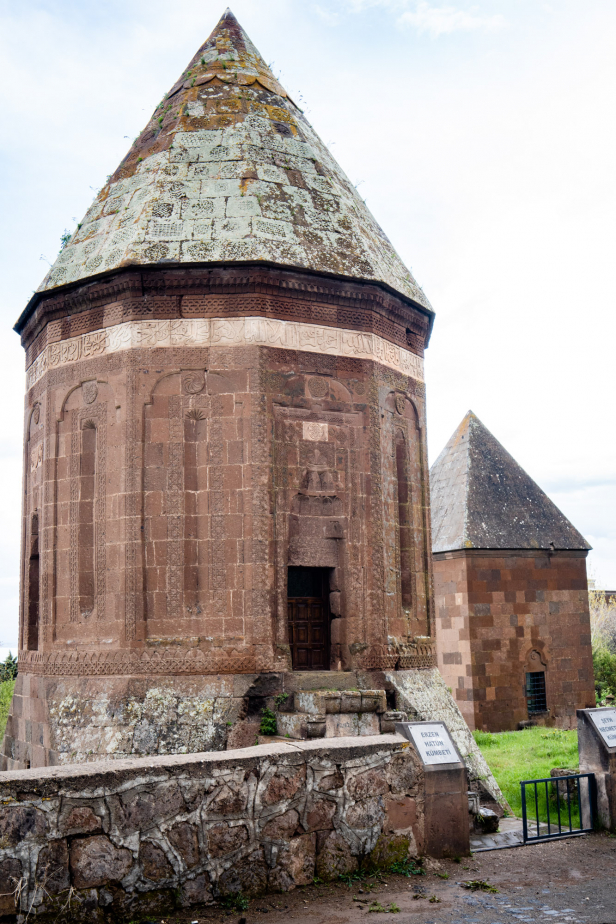
The more ornate Erzen Hatun tomb was built for the the daughter of Emir Ali, ruler of Ahlat, who died in 1396. Though not particularly large it is a display of skill of Ahlat’s masons. The deeply cut ‘V’ niches and pale band of calligraphy are particularly fine.
The tomb of Şeyh Necmeddin is quite simple and was built for the religious leader Necmeddin who died in 1222.
The Tombs of Erzen Hatun and Şey Necmeddin Tcan be found in the east of the town of Ahlat on Kayı Boyu Street.
The Twin Tombs – Çifte Kümbetler
With one built for Hüseyin Timur and his wife Esen Tekin Hatun, and the other for Bogatay Aka (Ağa) and his wife Şirin Hatun, these two similar kümbet have become known as the “Twin Tombs”. All four of these royals died within a short span of one another and the tombs were buit in 1281.
The Twin Tombs can be found near the center of Ahlat on Görgenler Street.
Emir Ali Kümbet
Alongside the Emir Bayındır Tomb this is one of the most unusual kümbet in Ahlat. Built for Emir Ali, governor of Ahlat in the 14th century, it is a break from the usually kümbet design. Rather than the typical masjid within a drum set atop a square grave chamber, the Emir Ali Tomb consists of a short octagonal cupola with an internal dome covering an open grave space. The square of the grave area is enclosed on three sides but open on its fourth with only a short wall creating an enclosure in front of the grave site.
Emir Ali Kümbet can be found in the east of Ahlat on Boğatay street, not far from the Emir Bayındır Tomb.
Dede Maksut Tomb
Across the street from the Emir Ali Kümbet is the tomb of Dede Maksut, a 16th century scholar. The tomb is a simple chamber rather than a Kümbet.
Subscribe to The Art Of Wayfaring
Mirza Muhammed Tomb
Over the course of centuries the street level has risen, leaving the tomb of Mirza Muhammed partially hidden beneath ground level. This tomb also breaks from the traditional kümbet design and consists of a simple square chamber topped by an octagonal-pyramid roof. The triangualr transition from square to octagon is tucked right under the plane of the roof, also making for a single continuous plane from top to corner.
The mosque next to the kümbet is a modern addition.
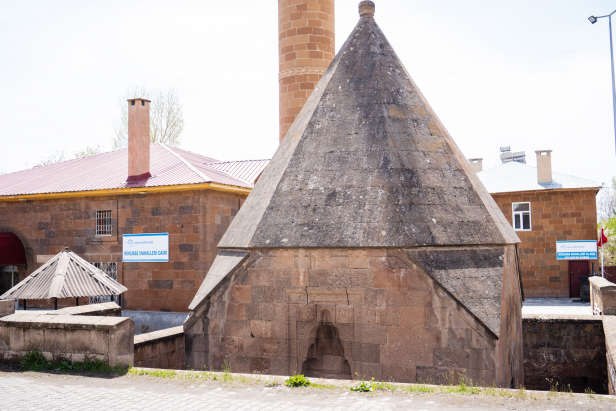
Mirza Muhammed Tomb can be found in the east of Ahlat on Boğatay street, not far from the Emir Bayındır Tomb.
Abdulrahman Gazi Shrine
The Abdulrahman Gazi Shrine is simultaneously the oldest and newest of the monumental tombs of Ahlat. Abdulrahman Gazi was a soldier among the armies of Caliph Umar, second caliph and ruler of the Islamic world following the death of the prophet Muhammed, who died in 641 during the Arab campaign against Ahlat. His grave has been a site of pilgrimage and sacrifice offering for centuries. The tomb however, was only built in 1974, in a style mirroring some of the historic tombs’ designs, most closely resembling that of the above mentioned Mirzah Muhammed Kümbet.
The Abdulrahman Gazi Shrine can be found in the east of Ahlat. Signage leading to the site are clear and easy to follow.
For another exquisite example of kümbet architecture see the Halime Hatun Kümbet in Van.
Traditional Ahlat Cane Makers
Ahlat Bastoncular
Cost: Free to Visit
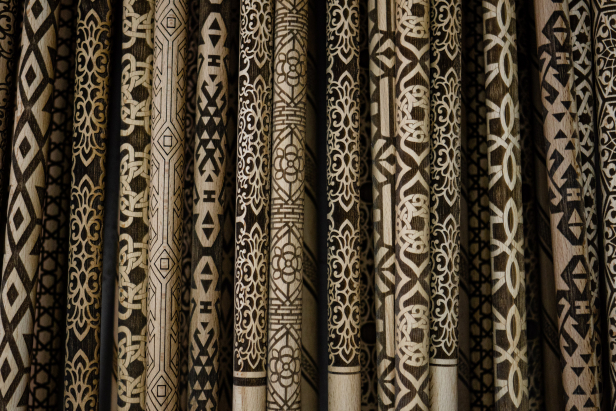
The best-known handicraft of Ahlat, you can still visit the workshops and showrooms of Ahlat’s traditional cane makers. Craftsmen shape walnut, mulberry, and buffalo horn to make walking sticks with traditional Seljuk patterns and symbols, celebrating the distinctly Seljuk identity of the city. Even US president Barak Obama received one during his visit to Turkey.
The Ruined City
Ahlat Harabeleri
Cost: Free
The historic city of Ahlat can be found on the western edge of the modern city, set on a mesa in the midst of the Keş Creek valley. The sides of the natural rock formation, known as the Seljuk Castle, are almost sheer, forming a natural fortification. Over time walls were added then, as the city grew new walls were built on the top of the outer edge of the valley while the settlement filled the valley itself. This site was occupied from the earliest founding of Ahlat down into the Seljuk period. It was only later, during the Ottoman period that the city moved and this site was abandoned.
Among the ruins you can see a number of historic buildings, the ruins of Seljuk bath houses, a bridge, traces of wall on the inner keep, and a number of cave buildings. One of these cave chambers has attracted special attention with lotus flower and peacock motif carvings above a nave. Experts believe it may have been a Yazidi or possibly a Buddhist temple.
Ottoman Castle
Osmanlı Kalesi
Cost: Free
As a part of the Ottoman campaign against the Persian Safavids Sultan Süleyman had a new castle complex built on the open hillside on the coast. The main settlement of Ahlat also moved, occupying a portion of the new castle with mosques and Turkish baths still standing. The castle consisted of an outer wall with a more heavily fortified inner keep, built into the south-west wall. While most of the castle is relatively simple, the inner keep holds the most impressive towers and gates and uses a great deal of spoila bearing Seljuk-style motifs.
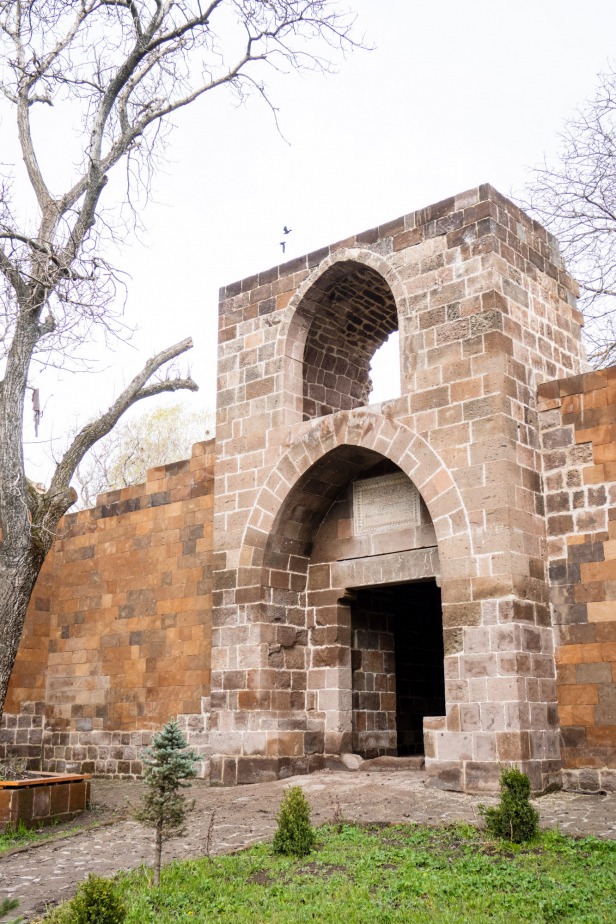
Below the inner castle, near the coast you can see a recently restored Turkish Bath, the Iskender Paşa Mosque, and the Kadı Mahmut Mosque, both built in the 16th century.
Ahlat Museum
Ahlat Müzesi
Cost: 10TL
Müze Card Accepted
For a small-town museum, the Ahlat museum is quite good, displaying finds from the various periods of the city’s history. A glaring omission is the Armenian history of the city which has been restricted to headstones on display in the garden.
How To Get There
General
The town of Ahlat is a major center in Bitlis, though it doesn’t sit along a particularly major road. While this is not a major route with many busses passing on to various other cities, there is still decent bus traffic to and from Tatvan and the Bitlis City Center.
If you come by personal car the roads here are good and as this is the only highway on the east side of the lake, Ahlat will be impossible to miss. From Bitlis take the E99 east, passing though Tatvan and following the coast until you reach Ahlat. If you are coming from Van (home to the nearest airport) take the D300 west across the south shore of Lake Van till you reach Tatvan, then join the E99 heading east to Ahlat.
For more about car rental and driving in Turkey make sure to read our full drivers guide.
Where To Stay
For a town of fair size, Ahlat is surprisingly short of hotel options. The Ahlat Öğretmen Evi is the best option as far as we could find. There are other hotels and even a campground on the east side of Ahlat.
Other Tips
Planning on visiting Ahlat? Make sure to check out what other sights are in the Lake Van area and Bitlis Province. While the major centers of Bitlis, Ahlat, and Adilcevaz may be very Turkic in nature, the history of the countryside still holds treasures of the Armenian people that once lived here. For more about the Armenian sites in the area see our guide to the Churches and Monasteries of Lake Van.
Subscribe to The Art of Wayfaring
Have any tips or info to add? Spot any mistakes? We’d love to hear about it.



